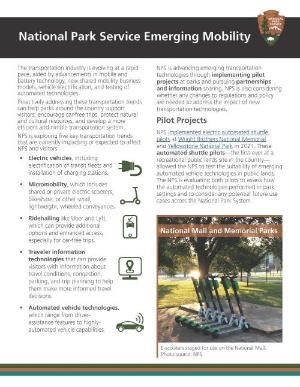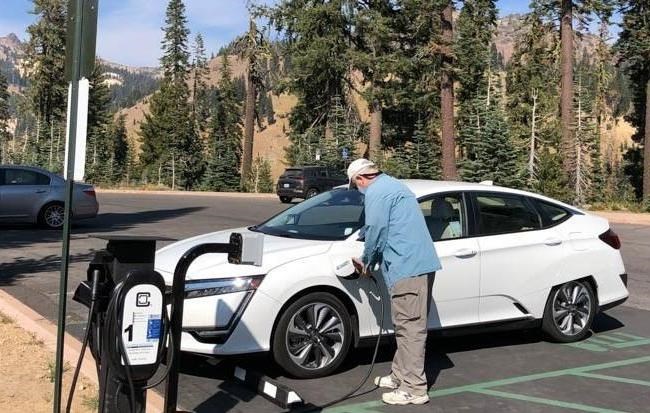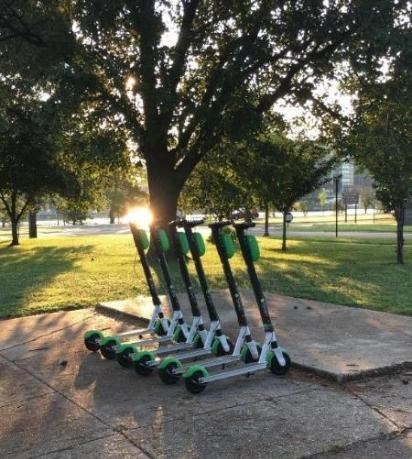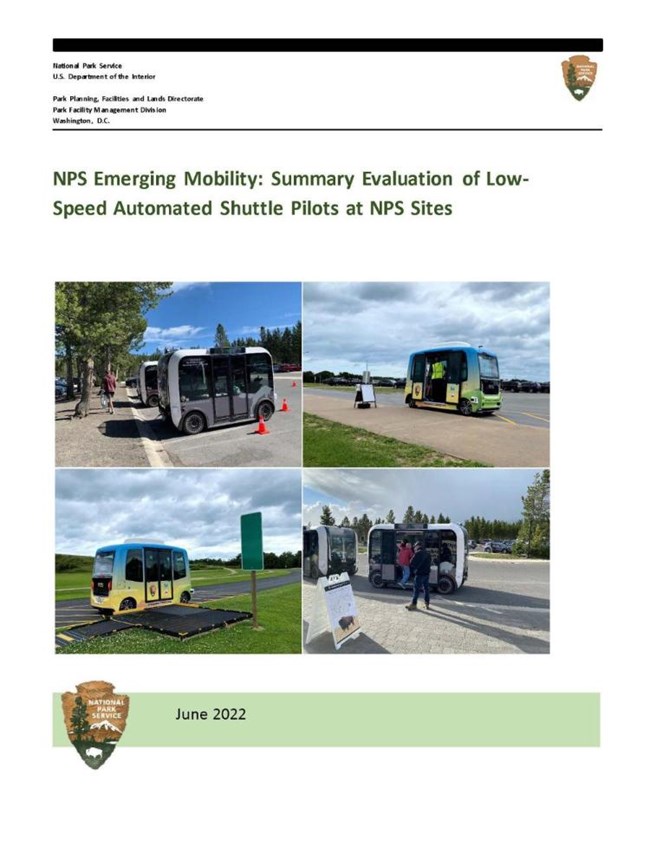
With input from staff across the agency and subject matter experts from the U.S. Department of Transportation (DOT), along with technical support from the U.S. DOT Volpe Center, NPS is assessing the resource protection, emissions, safety, equity, and visitor experience implications of these emerging mobility technologies and devising policy and program solutions. Proactively addressing these issues can help parks around the country support visitors and encourage car-free trips, reduce greenhouse gas emissions, protect natural and cultural resources, address logistical and policy issues, and develop a more efficient and nimble transportation system.
On November 17, 2021 Department of the Interior (DOI) Secretary Deb Haaland and DOT Secretary Pete Buttigieg signed a memorandum of understanding (MOU) between DOT and DOI on Transportation Innovation in the National Park System at an event in Washington, D.C. The MOU strengthens the collaboration between the NPS and DOT to continue working together to proactively address these emerging transportation trends. The first year brought many successes and accomplishments.
In April 2022, the NPS signed a Memorandum of Understanding with the State of Michigan to work together to advance emerging mobility and electrification initiatives. Five NPS units in Michigan are participating in the partnership, which seeks to identify mobility challenges and opportunities that can be addressed through emerging mobility pilots in and around NPS units in Michigan.

NPS Photo
Electric Vehicles and Charging
The NPS is pursuing vehicle electrification and electric vehicle charging infrastructure to reduce transportation carbon emissions. As electric and alternative fuel engines become more common in private passenger cars, it is important for NPS visitors with electric vehicles to have a place to charge their vehicles at and on the way to their destinations. The NPS aims to ensure its facilities can accommodate this shift to electric vehicles by planning and installing charging stations in parks, partnering on charging stations in nearby communities, and communicating information about charging infrastructure to visitors. NPS is also pursuing opportunities to electrify its own fleet, including its transit vehicles.
The National Park Service Electric Vehicle Transition report assesses the current state of NPS EV adoption, analyzes needs and gaps, and outlines the range of activities that the NPS will need to undertake to successfully transition to EVs and plan for the lifecycle maintenance of these vehicles.

NPS Photo
Micromobility
Micromobility includes shared or private electric scooters, bikeshare, or other small, lightweight, wheeled conveyances. This rapidly evolving field presents challenges as well as new opportunities. Washington D.C.’s Capital Bikeshare and Minneapolis’s Nice Ride feature bikeshare stations within NPS boundaries, planned in partnership with NPS. NPS sites in urban areas, such as National Mall and Golden Gate National Recreation Area, are coping with the sudden arrival of dockless e-scooter systems whose users sometimes leave these devices haphazardly blocking roads, sidewalks, or scenic views. Some parks are strategizing how to use micromobility devices to expand access to traditionally underserved communities, along with helping to close the first- and last-mile gap to transit and encouraging car-free trips. Working under these considerations, and with input from subject matter experts, NPS is currently pursing pilot projects at appropriate park locations to test out requiring visitors to park devices in designated corrals using geofencing technology and/or developing designated micromobility routes.Ridehailing
In many urban and suburban national parks, some visitors already access parks via ridehailing services such as Uber and Lyft, providing additional options and enhanced access, especially for those without cars. At the same time, rural parks are increasingly interested in working with ridehailing companies to reduce the need for expensive and environmentally disruptive new parking lots. NPS is pursuing ridehailing pilot projects in parks in order to test operational, infrastructure, and visitor experience impacts.Traveler Information Technologies
The NPS is using traveler information technologies as a cost-effective way to reduce congestion and improve the visitor experience at parks across the country. These encompass a range of technologies that can provide visitors with information about travel conditions, congestion, parking, and trip planning—and help them make more informed travel decisions. Part of the NPS strategy includes deploying infrastructure, also known as intelligent transportation systems (ITS), like transit vehicle locator systems, vehicle and parking lot counters, automated entrance gates, and variable message signs. The widespread adoption of smartphones and mobile technology also provides an opportunity to share real-time information with the traveling public, from bus locations to parking space availability to road closure information. NPS is exploring ways to enhance the newly released NPS smartphone app in order to integrate and provide visitors with trip planning and other transportation-related information.
Automated Vehicles
Over the past decade, significant advancements have been made in automated vehicle technologies, ranging from driver-assistance features to highly-automated vehicles capable of driving without human assistance. As these technologies continue to advance, they may change how people access and engage with national parks and introduce new considerations for NPS related to the development and maintenance of transportation systems.The NPS implemented electric automated shuttle pilots at Wright Brothers National Memorial (WRBR) and Yellowstone National Park in 2021. These automated shuttle pilots—the first-ever automated shuttle pilots at a recreational public lands site in the country—allowed NPS to test the suitability of emerging automated vehicle technologies in public lands. The two parks chosen for these pilots each represent a milestone innovation in American history that these pilots build upon. With WRBR as the location of the first successful airplane flights, and Yellowstone as the world’s first national park, these pilots build upon this historic legacy of innovation and advancement, allowing the NPS to test emerging technologies to chart a plan forward in the future of transportation to and within public lands destinations.
The WRBR pilot was conducted in partnership with the North Carolina Department of Transportation (NCDOT) and EasyMile. NPS selected vendor Beep, Inc. through a competitive process to provide automated shuttle service called The Electric Driverless Demonstration in Yellowstone (TEDDY) in the Canyon Village area for the Yellowstone pilot. Both pilots use electric vehicles capable of operating at SAE Level 4 automation. A trained safety attendant was on-board at all times to monitor vehicle operations and to take manual control of the vehicle if necessary for any reason.
The NPS, in partnership with the U.S. DOT Volpe Center, evaluated both pilots following their completion to assess how the automated technologies performed in park settings and to identify potential future use cases for emerging technologies across the National Park System. The full automated shuttle pilots evaluation report is now available. The NPS also collaborated with NCDOT and the Volpe Center on a separate evaluation report specific to the Connected Autonomous Shuttle Supporting Innovation (CASSI) Pilot at Wright Brothers National Memorial — the CASSI evaluation report is now available.
Evaluation documents for the automated shuttle pilots at Yellowstone National Park and Wright Brothers National Memorial include:
Last updated: June 29, 2023
